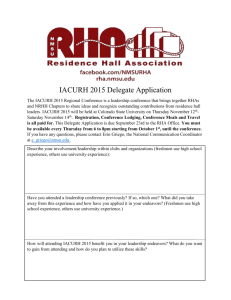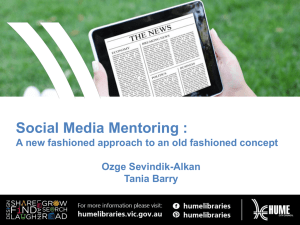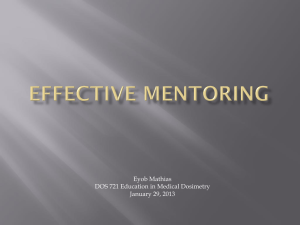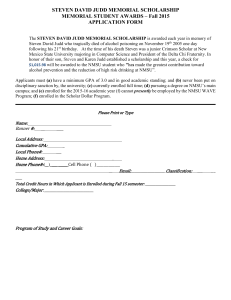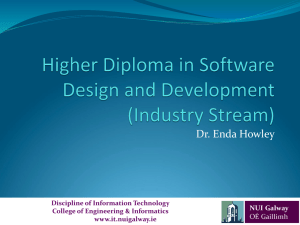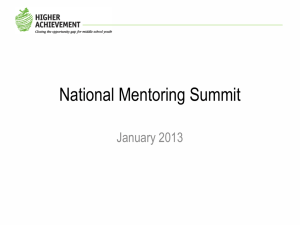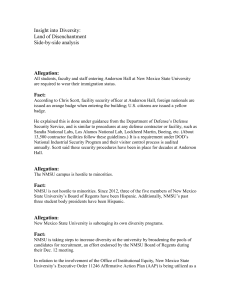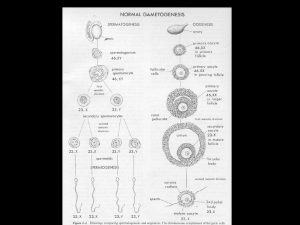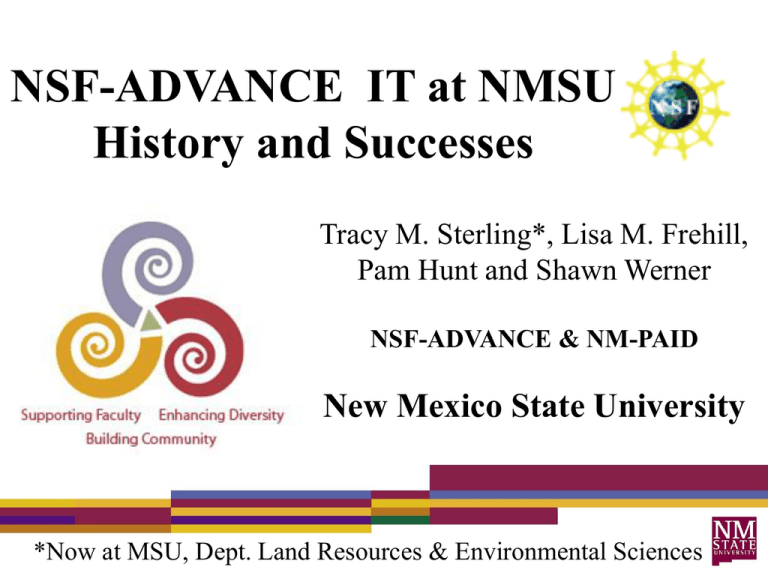
NSF-ADVANCE IT at NMSU
History and Successes
Tracy M. Sterling*, Lisa M. Frehill,
Pam Hunt and Shawn Werner
NSF-ADVANCE & NM-PAID
New Mexico State University
*Now at MSU, Dept. Land Resources & Environmental Sciences
• NSF-ADVANCE: Institutional Transformation
– New gender equity effort for NSF – 2001
– Issues prompting NSF-ADVANCE
• Women not being hired into academia
• Early career awards were not working
• S&E labor force was not keeping pace with demand
– Goals:
• Increase women’s representation among STEM
faculty and administration
• Transform academia
– 37 institutions funded, four rounds
Sex and Race Distribution for PhD Recipients
Compared to NMSU Tenured/Tenure Track Faculty
Science and Engineering Tenured/Tenure Track
Faculty at NMSU by Sex and Race, 2001
Science and Engineering Doctorates
Awarded by Sex and Race, 2001
1.7%
5.7%
2.0% 2.3% 0.3%
0.2%
2.0%
2.1%
White Male
White Female
4.2%
0.4%
2.6%
9.2%
Asian Male
Asian Female
5.8%
Hispanic Male
45.8%
Hispanic Female
Black Male
12.7%
Black Female
American Indian Male
American Indian Female
32.3%
67.6%
Major reasons for under-representation
of women in STEM disciplines
•
•
•
•
Pipeline
Chilly climate
Family/work balance
Unconscious bias
Source: Handelsman et al. 2005. Science 309:1190; Handelsman, J. 2008. DNA and Cell Biology 27:43-465
Valian, 1999, ‘Why so slow? Advancement of Women’.
Percent Female
Among
Recipients,
2005
Percent Female
Among Doctorate
Doctorate Recipients,
2005
100%
80%
60%
Parity Line: 49%
40%
20%
0%
y
s
n
s
og
ing
tics ience
ce
tio
ces
ce
l
r
a
n
a
n
o
n
e
c
em
cie
cie
cie
Sc
ine
du
ych
h
S
S
S
g
r
t
s
E
l
l
n
e
a
e
P
t
a
E
M
cia
Lif
pu
sic
o
y
m
S
Ph
Co
h
s
t c.
alt
e
t ie
i
e
,
n
l
H
na
ma
o
i
u
s
H
fes
o
r
P
Source: NSF Science and Engineering Doctorate Awards: 2005 . "Professional, etc."
includes professional, unknown, and other.
Arranged by: Commission on Professionals in Science and Technology; www.cpst.org
Percent URM Among Doctorate Recipients
Percent URM Among Doctorate Recipients, U.S. Citizens and
U.S. CitizensPermanent
and Permanent
Residents, 2005
Residents, 2005
50%
40%
Parity Line: 31%
30%
20%
10%
0%
.
e
g
s
s
gy
es
io n e alth nitie s , etc
es
nc
t ic
rin
t
ce
c
o
c
l
e
a
e
a
n
i
n
l
n
o
H
a
Sc
c ie them
ine Scie
na
cie Educ
ch
m
g
r
o
S
y
S
u
i
n
s
e
H
E
P
ss
al
ute
ia l
Ma
c
e
c
Lif
p
i
f
o
s
o
m
y
S
Pr
Co
Ph
Source: NSF Science and Engineering Doctorate Awards: 2005 . "Professional, etc."
includes professional, unk nown, and other. URM includes African American, Hispanic,
and American Indian.
Arranged by: Commission on Professionals in Science and Technology; www.cpst.org
Major reasons for under-representation
of women in STEM disciplines
• Pipeline
• Chilly climate
• Lack of mentoring
– Being the ‘one’ can be isolating
– Reliance on informal mentoring
• Competition vs. Collegiality
• Family/work balance
• Unconscious bias
Major reasons for under-representation
of women in STEM disciplines
• Pipeline
• Chilly climate
• Family/work balance
– Timing
– Multiple Postdoc positions
– Partner more likely to have PhD
• Unconscious bias
NMSU-ADVANCE: Approach
• Recruitment Initiatives
• Retention & Advancement Initiatives
• Policy Change Initiatives
• Data analysis & Dissemination
Recruitment
STEM new hires at NMSU
Pre- and Post-ADVANCE
70
61
60
56
Number
50
40
33
30
Male
Female
20
10
10
0
1996-2001
2002-2009
Data Source: NMSU Institutional Research, Planning, and Outcomes Assessment
STEM new hires at NMSU (% Females)
50%
45%
40%
35%
30%
25%
20%
15%
10%
5%
Data Source: NMSU Institutional Research, Planning, and Outcomes Assessment
2009
2008
2007
2006
2005
2004
2003
2002
2001
2000
1999
1998
1997
1996
1995
0%
Women as a Percentage of Tenured and
Tenure-Track Faculty at NMSU 1995-2009
45.0%
40.0%
35.0%
1995
30.0%
2000
2001
25.0%
2002
2003
2004
20.0%
2005
2006
2007
15.0%
2008
2009
10.0%
5.0%
0.0%
Agricultural Sciences
Natural and Physical
Sciences
Mathematical Sciences
Engineering
Biology
Retention and Advancement Initiatives
• Specific to female tenure-track in STEM
– Start-up Augmentation
• Depts/Colleges responsible for most of package
• Encouraged broader applicant pool
– Research and Travel Awards
• 36 women received $500,000
– Distinguished Visiting Professors Program
Retention and Advancement Initiatives
• Engagement across University
– Department Head Training
– ADVANCING Leaders: Leadership Development Program
• Two nominees from each of 6 Colleges and the Library
– Mentoring Program
• Program has grown from 31 participants in 2002 to 133
participants in 2010
• Equal participation by men and women
– Faculty Development
• Promotion & Tenure Workshops
• Development Training
Mentoring as a Key Transformative
Strategy at NMSU
• Mentoring encourages development of social ties
– Addresses a variety of career needs
– Improves Teaching, Research, Job Satisfaction
– Formal vs. Informal
• Avoid “boundary heightening” -- Should not “look”
like a gender-based approach (Kanter 1977)
• Approach at NMSU - Make Mentoring Normative
– Annual pairings
– Mentor training and networking events all year
(1) Connect mentees to mentors who are more
central and have denser social networks
Mentor’s
community
contacts
Mentee
Mentor
Mentor’s
colleagues
Institutional
Information
& resources
(2) On-campus on-going events
Create a larger community of mentors and mentees.
Mentor’s
community
contacts
Social
Networking
Mentee
Mentor
Mentor’s
colleagues
Institutional
Information
& resources
Programmatic Practices
• Make mentoring normative
– Practice: paired ALL new STEM faculty with mentors outside their
department, but within College.
– Invite senior faculty and administrators to participate
– Incorporated mentoring into leadership development programming
• Encourage interactions
– Practice: pairs complete agreements
– Practice: facilitated group interactions
• luncheons, assigned seating, table topics—not always with speaker
• mixers, dinners, picnics, open houses
• Training: mentors
– Share best practices and hints
– Increases connections among people with a positive orientation to
mentoring
– Encourage non-hierarchical practices
– Gender and ethnic equity issues
NMSU ADVANCE Mentoring Participants 2002-10
Number of Participants
140
All Colleges
120
STEM, Social & Behavioral Sci.
100
All
STEM
80
Mentors
60
STEM
40 females
Mentees
20
Total
0
02-03 03-04 04-05 05-06 06-07 07-08 08-09 09-10
Academic Year
- 133 participants; Both genders participating equally
Retention and Advancement
120
100
80
Assistant Females
Assistant Males
Associate Females
60
Associate Males
Professor Females
Professor Males
40
20
0
1995
1996
1997
1998
1999
2000
2001
2002
Data Source: Institutional Research, Planning, and Outcomes Assessment
2003
2004
2005
2006
2007
2008
2009
Policy Change Initiatives
• President’s Commission on the Status of Women
– Regular review of data, salaries within rank
– Proposed University Omsbuds position – now in place
– Gender equity / maternity policies – in preparation
• Promotion and Tenure Policy Revision
– Transparent criteria and roles
– Flexibility
– Allocation of Effort
• Employee Climate Survey – now every 3 years
• Exit Interviews
NMSU - ADVANCE:
Institutionalization
-
Sustainability of programs
- Fully-funded Associate Director Position
- To continue campus-wide faculty development
- Mentoring, P&T, Leadership training, DH Training
- Seeking sources for start-up funds
- President’s CSW, Omsbuds, Employee Climate Survey
• Additional Funding
– Legislative Initiative (Advancing Faculty Diversity)
– Development Campaign
– NSF-PAID – Partnering with NMT, UNM, LANL
• To disseminate best practices
NSF-ADVANCE PAID – Partnerships for
Adaptation, Implementation and Dissemination
NM-PAID
“Alliance for Faculty Diversity”
• Partners: LANL, NMT, NMSU and UNM
• To disseminate NMSU’s best practices of:
– Mentoring, P&T Training, Department Head training
– Pipeline focus on Post-docs
• Sustainable mechanisms for Institutional Transformation
NM-PAID Goals
• Increase knowledge of Diversity Issues and Strategies
– Mentoring approaches
– Promotion and tenure issues
– Department Head training
• Institutionalize sustainable grass roots structure for faculty
development training
– Sustainable grass-roots committees at each institution
• Supported by upper administration
• Including women and men
– Annual Department Head Retreats to promote diversity leaders within
the ranks
• Provide a pipeline to STEM careers for diverse students
– Postdoc and student training
– Participation in the professoriate


